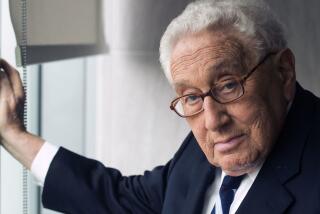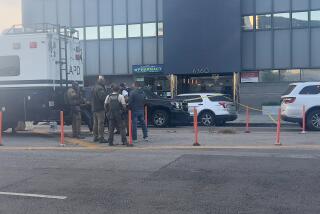Robert DeProspero, agent who overhauled presidential security after Reagan was shot, dies at 80
Robert DeProspero, a Secret Service agent who protected five presidents and retooled security standards after a would-be assassin shot President Reagan in 1981, died Monday in his home in Scottsdale, Ariz. He was 80.
His death was confirmed by his daughter, Robin DeProspero-Philpot.
During a 20-year Secret Service career, DeProspero became best known for the stern image of him captured in photographs from Reagan’s two terms in the White House. He was the 40th president’s constant shadow, never more than two or three steps away and often wearing a three-piece suit. Though just 5 feet 7, the onetime college wrestler had an intimidating presence. His body was thick with muscles from a strict weightlifting routine, and his protruding brow appeared permanently furrowed in concentration.
Known as “Mr. D” to his agents and “Agent No” among some White House staff, DeProspero frustrated a long line of political aides and foreign emissaries by politely yet firmly rejecting plans that in his view left the president too exposed to attack.
During Reagan’s first months in office, DeProspero clashed with White House Deputy Chief of Staff Michael Deaver over what the agent considered the White House’s lackadaisical approach to security. Deaver, who had helped create Reagan’s popular “everyman” image, had argued the president’s political success hinged on the removal of physical barriers between him and voters.
That philosophy was forgotten after March 30, 1981, when a would-be assassin, John W. Hinckley Jr., fired six shots from his revolver as Reagan stepped outside the Washington Hilton after giving a speech.
One bullet pierced Reagan’s lung. Others struck Secret Service agent Timothy McCarthy and Washington Police Officer Thomas Delahanty. White House Press Secretary James S. Brady, struck in the head, was left partially paralyzed. Hinckley, who said he hoped the assassination would impress actress Jodie Foster, spent 35 years in a government psychiatric hospital before being released in 2016.
In the months after the attack, DeProspero took over Reagan’s security detail. He imposed a raft of new security requirements, some of which remain standard Secret Service protocol.
He is credited with the agency’s decision to begin using magnetometers to screen guests to all presidential visits away from White House. Presidential advisors had long resisted such electronic frisking, fearing it might alienate invited donors and constituents.
DeProspero also enacted the policy, still in force today, of stationing an agent at the closest trauma hospital whenever the president travels.
DeProspero also successfully pushed for the installation of bulletproof glass on many White House windows, over the objections of the mansion’s historical preservationists.
Joseph Petro, a former Secret Service agent who trained under DeProspero and later rose to lead the Reagan detail, said his mentor was tough but beloved by the agents he led. He said he had a knack for spotting gaps in the rings of security that agents tried to form around the president, and then diplomatically demanding the holes be filled.
“His legacy will always be that he was an uncompromising agent,” Petro said. “He had principles, and he wouldn’t compromise them for anybody — not even the president. He set the standard for so many agents.”
DeProspero developed a close bond with Reagan, who he said never expressed any fear for himself after the shooting. In an interview, DeProspero recalled Reagan’s habit of cheerfully whistling as he worked at his “Western White House” ranch in Santa Barbara.
“Mr. President, you’ve got the weight of the world on your shoulders,” DeProspero told him. “You come out here and you just seem to be carefree. You’re my responsibility, and I can’t sleep at night.”
“Well, Bobby,” Reagan said, winking. “You gotta delegate.”
Leonnig writes for the Washington Post
More to Read
Start your day right
Sign up for Essential California for the L.A. Times biggest news, features and recommendations in your inbox six days a week.
You may occasionally receive promotional content from the Los Angeles Times.






